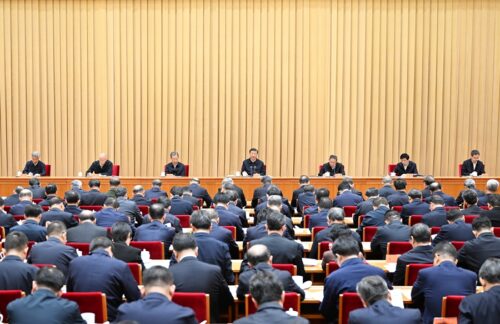Xi doubles down on ‘Chinese-style modernization’
China's past successes and future prosperity will 'dispel the myth that modernization is equal to Westernization,' Xi Jinping has declared.

Chinese leader Xí Jìnpíng 习近平 stressed “vigorously advancing Chinese-style modernization” in a speech to top Communist Party cadres and officials on Tuesday, just one month before China’s biggest annual parliamentary meetings known as the “Two Sessions.”
Chinese-style modernization is a “new model for human advancement” and “dispels the myth that ‘modernization is equal to Westernization,’” Xi said.
“Xi’s saying that modernization is not Westernization was not really new. He has said this before and it’s been Chinese discourse for some time now,” Manoj Kewalramani, chairperson of the Indo-Pacific Studies Programme at the Takshashila Institution, told The China Project. “What stood out for me was his remark that once the strategy is formed, it must be persisted with for a long time and that one cannot abandon or alter it as one wishes.”
“This is basically Xi reiterating that the reform agenda he has outlined over the past few years must be persisted with, even if one needs to make tactical adjustments depending on local situations or circumstances,” Kewalramani added. “I thought this was a cautionary instruction, given the recent signals regarding the easing of policies disciplining the property and consumer technology sectors, as well as indications to support more local government spending.”
Xi also stressed that innovation “must be placed in a prominent position in overall national development,” and to “achieve higher efficiency than capitalism while maintaining fairness in the society more effectively.”
“Xi’s comments at the meeting are another reminder that he sees the PRC in a systems competition with the U.S.-led West, and his view of economic development is very much not capitalism in any way that it is commonly understood” in the West, Bill Bishop, the author of the Sinocism newsletter, told The China Project.
China’s high speed growth to prosperity
China experienced an extraordinary period of rapid growth over the last few decades under the “Chinese path to modernization” — a model that lifted the world’s most populous nation largely out of poverty. It has allowed many of the basic needs of Chinese people to be met, and is often trumpeted by Chinese embassies around the world, particularly in developing nations.
What was once a country with a primarily rural, agricultural economy catapulted itself to upper-middle income status. The number of people in China living under the World Bank’s International Poverty Line — or below $1.9 per day — fell by about 800 million people over the past 40 years, or nearly 75% of the reduction in the number of people in extreme poverty worldwide.
An economic rebalancing act and growing pains
While China’s iron-fisted Communist Party and top-down governance model has enabled it to enact sweeping and transformative economic policies, China’s economy has started to plateau, further beleaguered by three years of strict COVID curbs, and government crackdowns on the technology, private education, and real estate industries. The rocketing growth of the world’s factory has slowed since 2011, and has been deemed “unsustainable” by economists and experts in the last decade or so.
China’s economic prosperity was enabled by other countries absorbing an influx of its manufacturing exports. But as China moved higher up the value chain, and as domestic and international markets took on new patterns, Beijing has had to make big changes to deal with emerging challenges like an aging population, rural to urban migration, and widening inequality.
For some years, Beijing has been trying “rebalance” its economy through painful structural changes aimed at keeping the engine running. Back in March 2007, then-Premier Wēn Jiābǎo 温家宝 announced that shifting domestic demand toward consumption would be a top priority of Beijing’s economic policymakers — a goal that has persisted through each political reshuffle.
The path forward for China
“To me, [the speech] was Xi warning his colleagues in the party that the current easing is not a rolling back of the agenda of reform. Foreign investors and private sector enterprises in China would also do well to keep this in mind,” Kewalramani told The China Project.
But that reform is certainly not political reform: Xi pointed out that the country must “adhere to national security” and suppress any threats to political stability. He also urged self-reliance, at a time when U.S.-led efforts have tightened up on the flow of key semiconductor technologies to China, hampering Beijing’s push to produce things like electric vehicles or digitize its economy. China is also considering new export restrictions on solar manufacturing technologies to shore up its global dominance in the solar industry.
Read more about The China Project’s predictions in our Red Paper for 2023.






